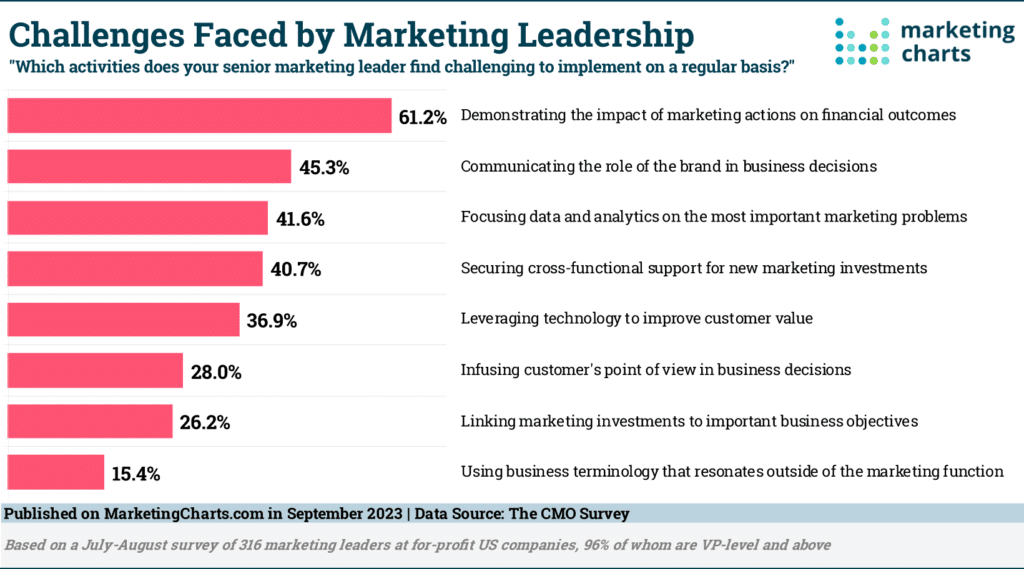We all know we should be breaking down silos for more efficient work. Keeping teams split apart leads to all kinds of issues where critical information doesn’t get passed freely, which means more product issues and customer communication issues.
We know we should be more collaborative.
But it’s difficult.
One reason Marketing doesn’t spend more time with Sales, R&D, I.T., Customer Service, or any other department is that your workflow may be too focused on the most immediate task. Unless you need to do some sort of research where you have to obtain information from another group, there’s little reason to cross the hall.
I’m guilty of this.
I work for a company of ten people, and I tend not to involve others until the last minute on a new project. I could easily avoid some headaches if I would pull in people faster.
But how do we actually change this pattern of working in silos?
Let’s start by looking at the pain of staying separated.
CMO Woes
In the 2023 CMO Survey, chief marketing officers shared their answers to the question, “Which activities does your senior marketing leader find challenging to implement on a regular basis?”

Collaboration won’t solve everything on this list, but involving others at an earlier stage could make a dent in some of these percentages.
41.6% of respondents find it difficult to focus data and analytics on their most important marketing problems.
Depending on the makeup of your company, you may have some folks in IT or R&D that could help you with setting up measurements or interpreting the results. Similarly, those teams could probably help with the 36.9% who are having trouble leveraging technology to improve customer value.
40.7% report that they have issues with securing cross-functional support for new marketing investments.
This stat, in particular, makes me wonder if marketing teams are coming up with their own solutions and then just trying to get everyone else to agree.
Your teams may not have the solutions to resolve all your issues, but they could be instrumental in helping you select the right one. Look for opportunities to bring in your more technical folks as advisors. (For more on working with I.T., check out Five Reasons Why IT Doesn’t Want to Support Your Next Martech Purchase.)
Customer service could likely help with infusing the customer’s point of view in business decisions.
Sales definitely needs to be a part of any process where you are trying to share lead information back and forth.
I’m not saying we should sit in a circle and sing “You’ve Got a Friend in Me,” but we can directly tackle some of our big marketing problems by engaging with others.
How Alignment Plays Out
Like any modern marketer that wants to understand how to better work with other humans, I asked AI what to do.
I’m using Jasper right now for these kinds of prompts, and here were the top recommendations:
- Foster open communication
- Cultivate a shared vision
- Align goals and objectives
- Leverage technology
- Encourage cross-training
- Promote a culture of collaboration
The reason I include this is that these suggestions are pretty straightforward. It’s relatively easy to think of ways to involve others, but we often don’t.
We have to make collaboration an integral part of our workflow.
Here’s an example. One marketing VP for a small medtech company recently shared that their company created a single product suggestion mailbox where anyone from sales, marketing, or R&D could submit ideas.
This gives everyone permission to participate and make suggestions about the product itself or how the company is communicating with potential customers.
That same company is leaning more heavily into the agile marketing approach to integrate teams and move more quickly. I’m just listening to my first audiobook on the topic, but you can get up to speed on the model with this article from McKinsey & Company.
At its core, agile marketing advocates creating small teams that have enough different types of talent to be able to tackle individual assignments completely. This means there’s no two-week wait for another department to review their needs.
Of course, agile marketing isn’t the only way teams can collaborate.
I think the most important part of shifting our workflow is making room for the unexpected benefits that can come from making time.
A Vendor’s Perspective
At Health Connective, we often work as an extension of our client’s teams. We tend to sit at the intersection of a few different teams, like product marketing + R&D or marcom + IT.
We get the chance to see teams excel and struggle with this concept of collaboration. No team has a perfect track record here, but it’s really energizing to see people rally around a need.
Here’s a quick example. A lot of folks don’t think of drafting privacy policies as their idea of a good time. It’s critical work to getting a branded experience live, but it involves a lot of detail—often quite technical in nature.
Bringing together developers, marketers, and policy folks is a major chance for collaboration, and these conversations can yield results that may benefit many future projects if people can take enough time to go beyond the task at hand.
We were involved in a project where we were helping set up an application for customers to use, and any analytics gathered would only be used in-house. Meaning, Google and Facebook doesn’t get any access to the user behavior gathered in this experience. So, as we looked at all of the privacy language drafted for an online experience, the assembled team began to see some major revisions that could be made for these types of projects.
By combining knowledge from each group represented, we were able to help reduce the amount of items customers would have to consent to while still providing the full level of protection needed in the situation.
This work became the foundation for other, similar projects, making the burden easier on future teams.
Albeit a small win, it allows a large company to move a little faster in a market that’s moving at a blinding speed.
Your Homework
Collaboration is not a “nice to have.”
If companies are going to compete today, they have to look for ways to continue to be more efficient and productive.
Your homework: pick one team where you can integrate more. Don’t just think of the easiest team to work with, where you already have a good friend.
Look for the team that will cause the biggest impact on behalf of your company.
Start there, and solidify the relationship before trying to reach out to any other teams. Track the benefits of your efforts, and note your unexpected challenges. That way, you’ll be all the more prepared to continue building your collaborative team.
Michael spends a great deal of time with the healthcare industry both professionally and personally, which gives him the perspective of what stakeholders on either side of the care equation need.
He began coding in 2008 and subsequently shifted his attention entirely to online marketing. Michael completed his MBA in 2018, focusing on the intersection of healthcare and marketing.

